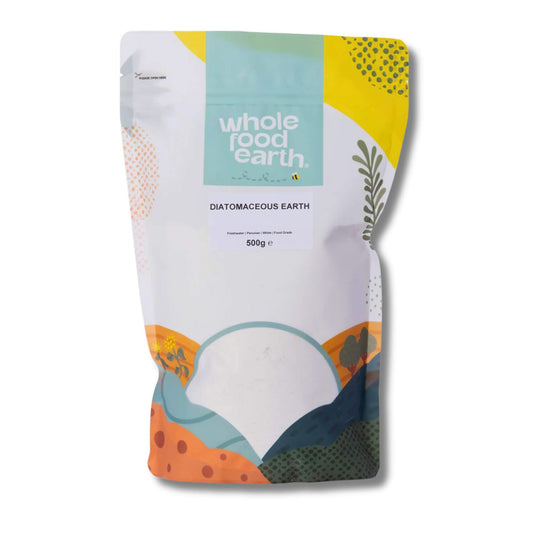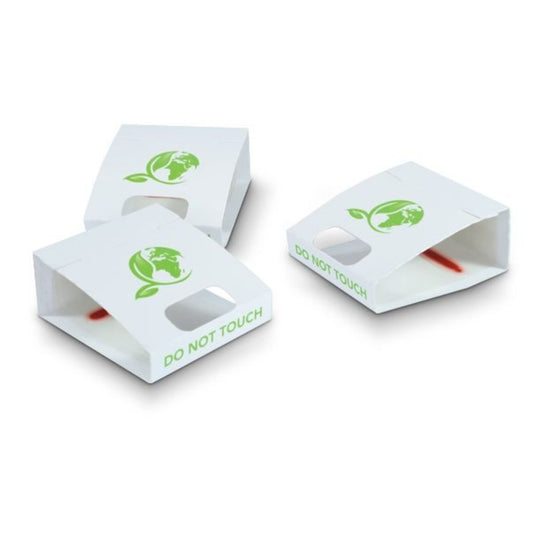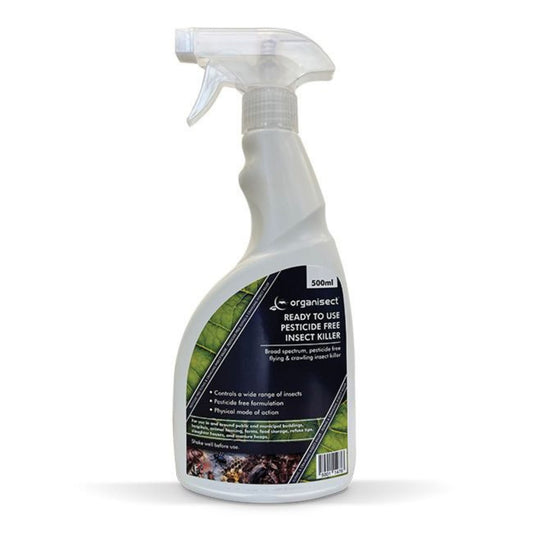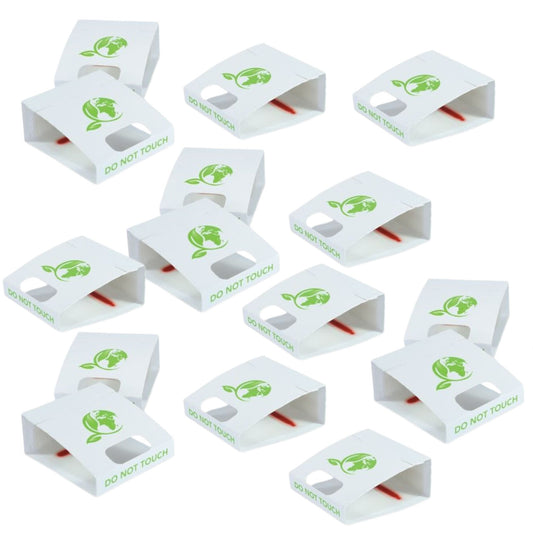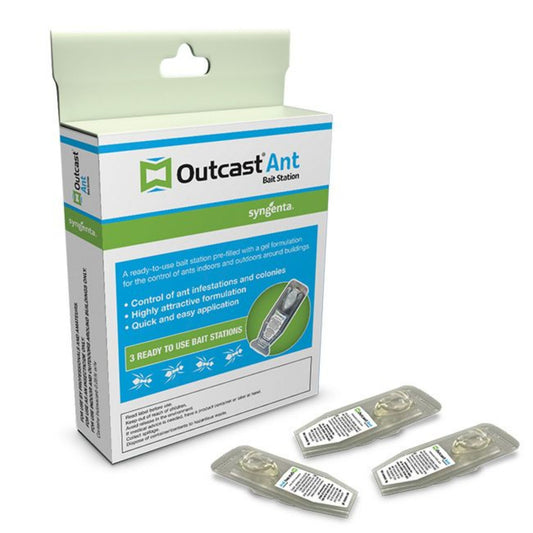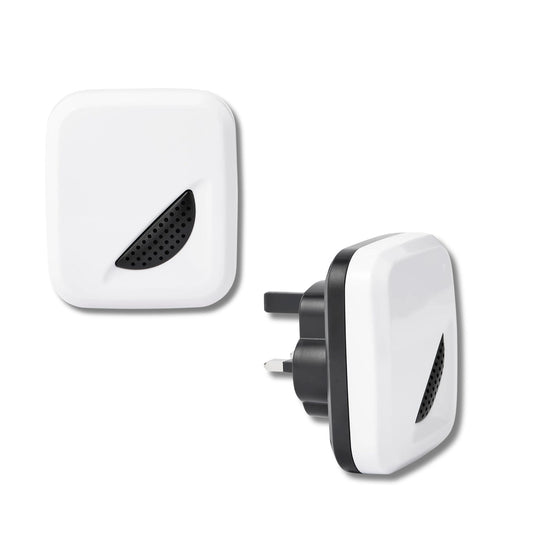
Expert Guide on How to Get Rid of Ants Yourself
Share
There are billions and billions of ants in the world, and a tiny proportion of them live in your home and garden. Even though most ants are largely harmless, if you notice them in your home, it's important to take action quickly, Otherwise, the situation may get out of control.
Pest control companies often provide ant control services, however they often charge high fees. With the right products and some sound advice from our team at PestBuddy.co.uk, you may be able to address the ant situation yourself quickly and effectively.
This expert guide on how to get rid of ants yourself provides everything you need to know. From understanding ant behaviour to choosing the right DIY ant control products, we've got you covered.
Are Ants Dangerous?
Should you worry about these little creatures and do something about it?
The short answer is yes! Ants can wreak havoc on indoor and outdoor spaces if left to their own devices.
Indoors, ants walk through drains or dustbins to get to the food on your countertop, contaminating the food you have left out with bacteria. They can cause serious issues in places such as hospitals or food production facilities where developing populations can affect public safety.
Outdoors, ants can be a significant nuisance, causing damage to wooden structures such as decks and fences.
Types of Ants
There are more than 13,000 different species of ants around the world, but only a small percentage of these live in the UK due to the colder climate.
Most of the ants you see invading your home are likely to be female worker ants foraging for food, which they take back to their nest to feed the larvae and the queen ant.
Most ants are between 3-5mm in length and have three main parts of their body. They are the head, thorax and abdomen, which are clearly separated by very narrow waists. They also have a sharp elbow joint on each antenna segmenting them into two parts.
Black Garden Ant (Lasius niger)
The black garden ant (lasius niger) is the most common and well-known ant species in the UK and are comfortable living both indoors and outdoors. Despite their name, they are actually very dark brown in colour. Black garden ants like to nest under paving or in the soil along the edges of lawns. They also live inside the cracks around your house, and anywhere else they can find shelter.
Black ants make their way into your home in search of food, and because they love sweet substances, they are often referred to as sugar ants. You will find them around honey and jam jars or feasting on the piece of cake you left out. They have a varied diet, though, and are useful for cleaning up dead insects and the larvae of flies and beetles. They may be ferocious in their foraging habits, but they are largely harmless to humans as they don’t have a sting.

Yellow Meadow Ant (Lasius flavus)
Another common ant in UK gardens is the yellow meadow ant (Lasius flavus). These ants are often mistaken for red ants due to their orange-yellow colour, but they don’t bite and are quite harmless to humans. They build large mounds in meadows and lawns and forage underground on insects and larvae.
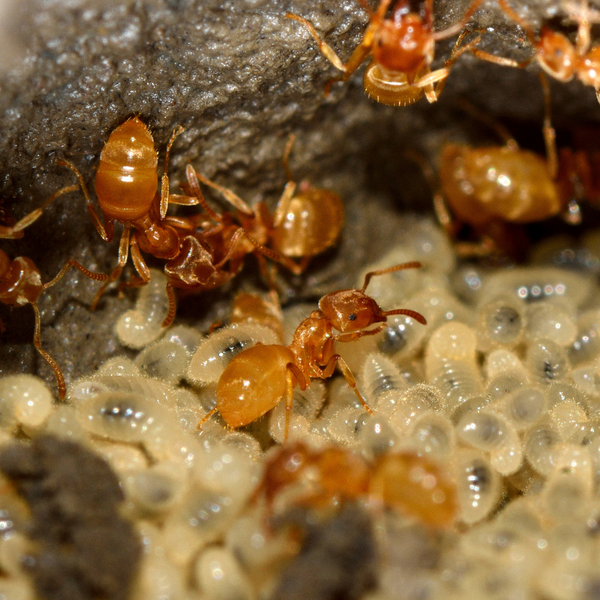
Yellow Lawn Ant (Lasius umbratus)
Lawn ants (Lasius umbratus) closely resemble yellow meadow ants. However, they have a somewhat unorthodox way of establishing their nests. After mating, the queen kills an ant from another colony and uses its scent to take over the murdered ants' nest.
Once she has entered the nest and been accepted by the worker ants, they will kill their queen and look after the yellow lawn ant queen and her brood instead. As the existing worker ants no longer have a queen ant in the nest, they will not be replaced when they die off, and the nest becomes exclusively comprised of yellow lawn ants.
Jet Black Ant (Lasius fuliginosus)
Jet black ants (Lasius fuliginosus) are jet black in colour, slender, and have heart-shaped heads. They are larger than the black garden ants and build carton nests out of wood that has been chewed into a pulp and combined with honeydew, forming a hard crust when it dries.
Like the yellow lawn ant queen, the jet black ant queen is unable to establish her own colony and will take over another ant colony killing the queen and gradually taking full control of the nest.

Red ants (Myrmica)
There are several species of red ants in the UK, the most common being myrmica ruginodis. They live in very small colonies of between 100 and 300 members.
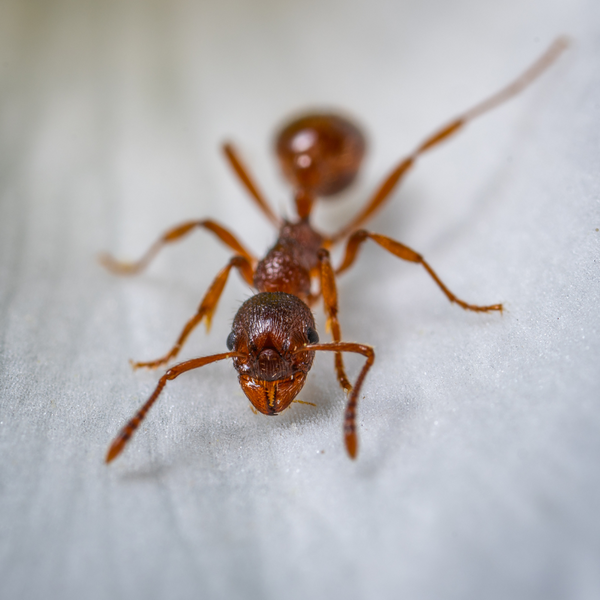
Another species, myrmica rubra, also known as the European fire ant, is aggressive and will even attack spiders.
Wood ants (Formica)
There are several species of formica ants in the UK. Formica rufa, also known as the red wood ant, southern wood ant, or horse ant, builds huge mounds of wood litter in forest clearings and pathways. They often number more than 100,000 ants in the colony and collect up to 100,000 insects and larvae in one day.
Formica fusca is another wood ant that is black and less aggressive than the rufa ant. They can be found nesting under rotting logs and have small populations. They may be polygynous (having more than one queen), but usually limit the number of queens to just a few per nest.
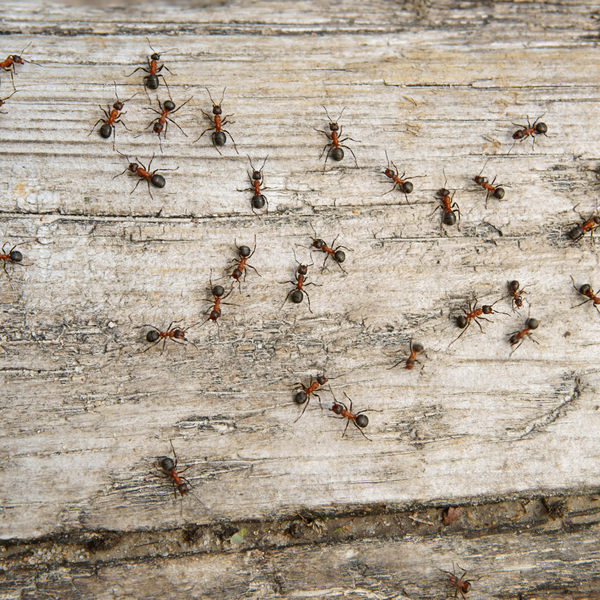
Ant Behaviour
Ants are social creatures who live in highly organised communities. Ants are more active in warmer weather. This is why you will see them streaming into your home during the summer months, foraging for food to keep them going during the cold winter days.
When a worker ant comes across a tasty morsel of food, it releases a tiny drop of pheromone and continues to do that all the way back to the nest. In no time at all, a long line of ants is making its way towards the latest food source. Ants are hard little workers, capable of carrying between 10 and 50 times their body weight. They can do this because their bodies are mainly composed of muscle.
Some species of ants take care of dead and rotting wood, while others pollinate plants and spread seeds. We often see ants dragging a dead insect into their nest or carrying crumbs along a pathway towards a tiny crack in the floor or skirting board.
Why Ants Invade Homes
There are several reasons why ants would suddenly invade your home. Their primary focus is on food, and they send out search parties from spring through summer and into the autumn months.
When the weather is dry, ants may come in search of water, and you can sometimes find them clustered around the rim of a tap, drinking from a droplet of water.
When the weather is wet, however, ants may make their way inside when their nests have been saturated with rainwater. They will then find a useful crevice within the walls of your house and move their nest indoors. You may see a long line of ants carrying their eggs inside as they relocate to a warmer, safer place in your home.

Breeding Habits of Ants
Ants are one of the most robust insect species on the planet and, as a result, one of the most abundant with their complex breeding habits and ability to survive in various ecosystems.
Ant breeding habits differ from species to species. Some ant colonies have one queen, while others are polygynous, having from two to hundreds of queens. Some colonies are relatively small, such as the Red Ant, with an upper limit of around 300 members. Wood Ants, on the other hand, breed colonies of up to 100,000 ants.
In addition to at least one queen, each ant colony starts with a number of winged males and one or more winged, virgin females. These are the reproductive ants and they fly out of the nest in search of a mate from a different colony for a few days around July and August. Their wings take them away from their nest, ensuring that there is little in-breeding in colonies.
After mating, the queen looks for a suitable place to build a new nest or takes over another colony’s nest and she begins to lay her eggs. If she is in her own nest she raises her brood single-handedly until she has raised a formidable team of female worker ants who are able to take care of the eggs, larvae and pupae.
Fertilised eggs become either female workers or future queens. The queen is in control of her colony; she secretes a substance that stunts the growth of wings and reproductive organs, rendering her female workers unproductive. Once she has enough workers, the remaining females are left to develop into virgin queens. Unfertilised eggs become winged males with the sole purpose of flying away to fertilise queens from other nests.
In some ant species, the process of producing queens and males can take years to achieve. Some polygynous ant species send workers out to support one of their fertile queens and build her a new nest in which to lay her eggs. This is known as colony budding – the establishment of a new nest without going through the mating process.
Some species of ants have only one queen, and when the queen dies, it means the end of the colony as there is no queen to continue with the reproduction process.
Ant eggs turn into larvae - cream-coloured grubs without legs - that change into pupae in due course. The pupae are a smaller version of adult ants, initially cream-coloured, but eventually taking on the same colour as the adult ants.

Health and Safety Risks
As mentioned earlier, ants walk over dirty drain areas and other toxic substances to get to the food lying on your kitchen counter. As such, they are a risk to your health and safety.
Some ants have nasty bites and can cause allergic reactions in people who are prone to allergies. They frequently shed their exoskeletons, and those small particles that you find outside an ant nest can cause asthma attacks when they are airborne. Some ants carry pathogens that can cause disease.
Identifying Signs of an Ant Infestation in House
Spotting an ant infestation early can save you a lot of hassle further down the line. As ants are social creatures, when you see one, there's likely to be a colony not too far away. Here are some key signs to help you spot an ant infestation.
Ant Trails and Foraging
One of the most visible signs of an ant infestation are ant trails. Most commonly, these trails form the route between food sources and the ant nest. So observing a consistent flow of ants moving along the same path indicates an established trail to a nearby colony. Ants are attracted to sweet, sticky, or greasy food residues, so seeing them in your pantry or on countertops is also a clear indicator.
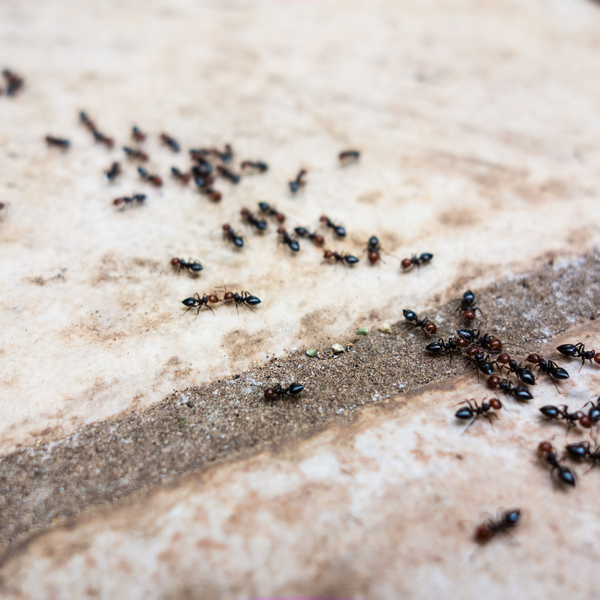
Ant Nests
Ant nests can vary in appearance, but they often look like small piles of soil or dirt. Some species prefer to nest in walls or other quiet, dark places, so an obvious mound may not always be visible. Look for fine dirt, sand or earth pellets in unusual places, such as along baseboards, in corners, or under appliances, as these can be signs of indoor nesting.
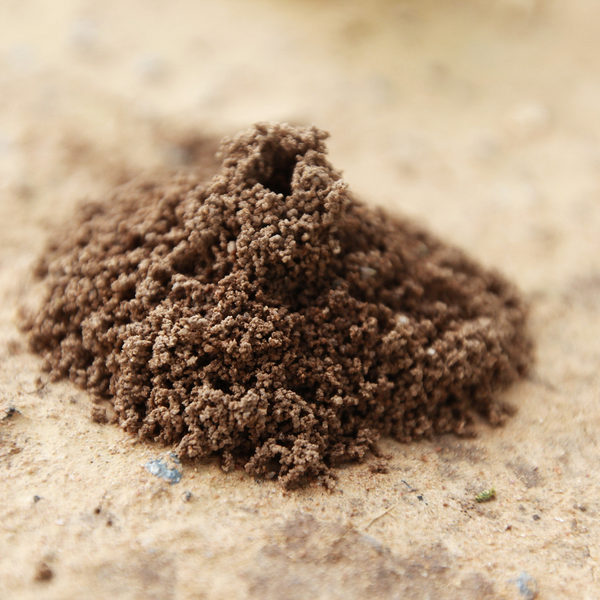
Damage to Buildings or Plants
Various ways ants cause damage exist. For example, carpenter ants are able to burrow into wood to create their nests, which can weaken structures and lead to costly repairs. Look for small piles of wood shavings or sawdust-like material, which can be a sign of carpenter ant activity. Additionally, some species might damage plants in your garden or farm.
Winged Ants
The presence of winged ants inside your home can be an indication that an ant colony is nearby. These winged ants are the reproductive members of the ant colony, often venturing out during spring or summer to start new colonies.
If you notice any of these signs, it's important to act quickly to address the infestation before it worsens. Early intervention is key to preventing significant damage and ensuring your environment remains safe and pest-free.
Common Locations for Ants and Ant Nests
Ants can establish their nests almost anywhere, both indoors and outdoors. If in doubt, simply watch the ants go back and forth from their nest to the food source. Ants do have known preferred spots:
Indoors
- Wall Cavities: Ants can build their nests within walls, especially if they are damp.
- Kitchens & Bathrooms: These areas attract ants due to the availability of food and moisture.
- Under Floors: Ants can be found especially in damp areas or where the floor is directly on top of the ground.
Outdoors
- Soil: Look for small dirt mounds in your garden.
- Under Paving: Cracks in driveways or sidewalks can hide nests.
- Decaying Wood: Carpenter ants prefer moist, rotting wood.
- Foundation Walls: Inspect for ants near cracks or debris near the house.
Preventing Ants in Your Home
An important part of ant control is stopping ants from getting into your home in the first place. This is sometimes harder than you might think, as ants are incredibly adept at finding new paths or nests if their usual ones are blocked.
If you are already aware of having ants in your home, prevention alone is unlikely to fully remove them. Instead, use these prevention techniques together with ant trapping and removal techniques.
Sealing Entry Points
Effectively preventing ant colonies from entering your home requires sealing all cracks and holes around the floor and wall edges with cement or silicone filler. Remember, no hole is too small for ants to get through. Follow the streams of ants to identify the nest entrance, then give the hole a good spray of insecticide, and seal it.
Ant infestations outside your home may be easier to control. Depending on whether you have pets or children around, consider a natural remedy before resorting to poisons. A quick and effective solution is to pour boiling water into the nest. Don't forget to also look for cracks around the exterior of your house and seal them using cement or silicone.
Sanitation and Housekeeping
Worker ants, being foragers, generally prefer sweet substances. Store all food out of reach, in sealed containers or in the refrigerator. Clean kitchen surfaces and sweep floors.
Outdoor Maintenance
Some outdoor ants build nests under rotting leaf piles, others beneath or within ground-level branches. If possible, thoroughly sweep the ground to expose holes and nests. If a nest is under your paving, lifting some stones may be necessary to reach it. Remember that there may be thousands of ants and larvae in the nest, thus, merely spraying or pouring liquid into the hole may not eliminate the entire population.
Using Natural Solutions
To prevent ants from moving in, consider washing surfaces with a DIY natural mixture. Several natural ingredients can deter ants without harming children or pets:
- Vinegar
- Citrus
- Lavender
- Coffee grounds
- Essential oils
Ant Control: Effective Ant Trapping and Removal Techniques
The long line of ants you see making its way into your kitchen is just a fraction of those left down in the nest, so don’t think that by wiping out the visible ants on your kitchen counter, you have made a dent in the population.
How to Get Rid of Ants Nests
Once you have identified the nest entrance, the first step involves targeting the queen ants. Destroying them prevents further egg-laying, leading to the colony's collapse.
For nest removal, firstly consider non-toxic methods like pouring boiling water into the nest site, but only if it's safe to do so without damaging your property. You may also consider using non-toxic ant killer sprays or powders such as diatomaceous earth.
More commonly, you can use ant traps containing highly attractive poisonous bait that worker ants carry back to the nest, inadvertently poisoning the queen and others.
Some ant species create separate nests nearby so it's important to check the surrounding areas for additional nests.
Types of Ant Traps
Most effective types of ant traps involve coaxing worker ants to take the bait back to their nest for the larvae and queen, destroying the colony.
Ant Bait Station Traps
Ant bait stations are enclosed devices containing insecticide bait. They attracts worker ants who then carry the poison back to the nest.

Ant Gel Baits
A more versatile option, gel baits can be applied in cracks, crevices, and areas where ants are active, providing a discreet solution.
Ant Borax-Based Solutions
Borax, a powdery white mineral, is commonly used as a cleaning product. Mixing borax with a sweet substance like sugar, honey, or syrup can effectively attract and poison ants while being less toxic to humans and pets. A common ratio is 1 part borax to 3 parts sweet substance. You may find it helpful to dilute the mixture with a little water to achieve the desired consistency.
Placement and Baiting Strategies
Place traps along ant trails and near entry points but well out of reach of children and pets. If possible, although not strictly necessary, use a variety of baits to appeal to ants' changing food preferences, alternating between protein and sugar-based baits. A typical rule of thumb is to aim for around 1 to 5 bait stations per 40m2.
Safe Removal and Disposal
Always wear gloves when handling traps and dispose of used traps in sealed bags.
When to Use Chemical Ant Killers
Consider chemical solutions for severe or persistent infestations where non-toxic methods such as pouring boiling water over nests or using non-toxic ant killer sprays and powders have failed or are not feasible. Many of the solutions listed above such as baits are likely to contain some chemicals to be effective so do check the product information carefully.
Safety Precautions with Chemicals
Always adhere to product instructions and wear protective gear like gloves and masks. Also, keep chemicals away from food areas, pets, and children.
When to Use Professional Pest Control Services for Ants
When to Call the Experts
In some cases, seeking professional help from a pest control service may be necessary.
If DIY methods fail or the infestation reoccurs, this may indicate a larger or more complex problem which needs to be put under control. Consider professional support for dealing with aggressive species like fire ants or large carpenter ant colonies which may pose structural risks.
Advantages of Hiring Professional Ant Control
Hiring professional ant control services offers several advantages. Experts can access more potent treatments and apply them safely. They can also identify specific ant species and tailor their approach, ensuring a more effective and lasting solution.
Final Thoughts
While ants have their place in the food chain, they can be destructive and pose health hazards. If they are not causing a problem in your home or immediate surroundings, let them be. Otherwise, try the suggested non-toxic methods first before moving onto more lethal alternatives. If all else fails, a professional pest control expert can offer advice and potentially provide a more permanent solution.
At PestBuddy, we're here to empower you with effective, fast and easy-to-use DIY ant control products. Explore our range of products to take control of your pest problems with confidence.

